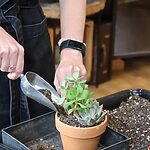Introduce a unique and eye-catching element to your plant collection with the Staghorn Fern, scientifically known as Platycerium bifurcatum. Named for its striking fronds that resemble the antlers of a stag, this fern is a true statement plant that can add a touch of wild beauty to any indoor space. Staghorn Ferns are highly versatile: smaller plants are perfect for creating lush, green displays in moss bowls or terrariums, while larger specimens can be mounted on a piece of bark, making a stunning and natural wall feature. These ferns thrive in bright, indirect light and high humidity, making them a great choice for homes, offices, or any space that could use a touch of greenery. Plus, Staghorn Ferns are pet-friendly, so they are safe for households with cats and dogs.
Care Guide for Staghorn Fern:
- Light: Staghorn Ferns thrive in bright, indirect light. Avoid direct sunlight, which can scorch their delicate fronds. A spot near a north or east-facing window is ideal, or use filtered light through a sheer curtain.
- Water: These ferns prefer consistent moisture. Water them once a week in warmer months and reduce frequency in winter. For mounted ferns, soak the entire mount in water for 10-15 minutes, then allow it to drain. For potted ferns, water when the top inch of the moss or soil feels dry. Mist regularly to maintain humidity.
- Humidity: Staghorn Ferns love humidity, making them perfect for bathrooms or kitchens. Aim for 50-70% humidity. Use a humidifier or mist the plant regularly if the air is dry, especially in winter.
- Temperature: Keep Staghorn Ferns in a warm environment, ideally between 18-24°C. Protect them from cold drafts and temperatures below 10°C, which can damage their fronds.
- Soil and Mounting: Staghorn Ferns can live without soil. Smaller ferns thrive in moss bowls or terrariums, where they can enjoy high humidity and a stable environment. Use sphagnum moss to provide moisture. Larger ferns are typically mounted on wood or bark using sphagnum moss. This mimics their natural growing conditions and allows air to circulate around the roots, which is essential for their health.
- Fertiliser: Feed Staghorn Ferns with a balanced, water-soluble fertiliser diluted to half-strength once a month during the growing season (spring and summer). Reduce feeding in autumn and winter when growth slows.
Troubleshooting Tips:
- Brown Fronds: Some browning on the shield fronds (the flat, round fronds that attach to the mount or growing surface) is normal as they age. However, if fertile fronds (the antler-like fronds) are browning, it could indicate under-watering or exposure to direct sunlight. Adjust watering and lighting accordingly.
- Yellowing Fronds: Yellowing can be a sign of overwatering or poor drainage. Ensure your fern is in well-draining conditions, whether mounted or in a moss bowl, and adjust watering frequency.
- Dry, Crispy Fronds: Low humidity or insufficient watering can cause fronds to dry out and become crispy. Increase humidity levels and make sure the plant is receiving adequate water.
- Pests: Keep an eye out for pests such as scale or mealybugs. If found, treat with insecticidal soap or neem oil, and increase humidity to deter pests.
The Staghorn Fern is a truly unique, pet-friendly plant that brings a touch of natural artistry to any indoor space. Whether displayed in a moss bowl, terrarium, or mounted on a piece of bark, this fern will thrive with the right care, providing lush, green beauty for years to come. Its ability to live without soil makes it an exceptional choice for creating striking, natural displays.











